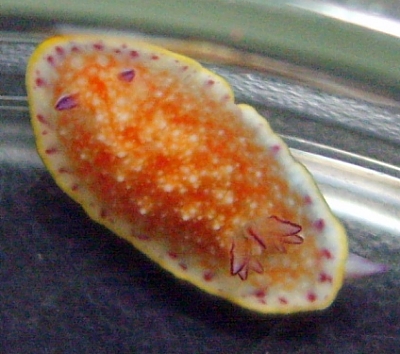
Chromodoris cf. regalis
Order: NUDIBRANCHIA
Suborder: DORIDINA
Superfamily: EUDORIDOIDEA
Family: Chromodorididae
DISTRIBUTION
Known only from Yucatan, Mexico, Gulf of Mexico.
PHOTO
Locality: Sisal , 18 m, Yucatan, Mexico, Gulf of Mexico, 8 Agust 2007. Length: 10 mm. Photographer: Jazmin Ortigosa.
This looks quite like Chromodoris regalis but the purple coloration on the gills and rhinophores and the spots around the mantle edge look rather different. There also seems to be a purplish coloration on the posterior part of the foot which is also different.
Authorship detailsRudman, W.B., 2007 (October 3) Chromodoris cf. regalis [In] Sea Slug Forum. Australian Museum, Sydney. Available from http://www.seaslugforum.net/find/chrocfrega
Related messages
Sponge of Chromodoris cf regalis
December 6, 2007
From: Jazmin Ortigosa
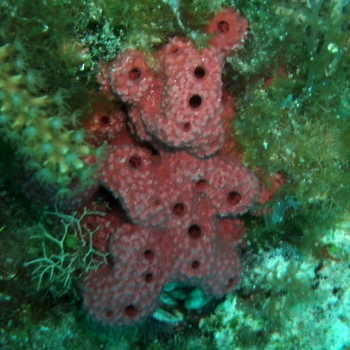
Concerning message #20924:
Dear Bill,
I send you a photo of the sponge where I have found the Chromodoris cf regalis. All the specimens I have were collected in sponges like this one.
Locality: Reef, 18 m, Yucatan, Mexico, Gulf of Mexico, Octuber, 2007. Length: 14 cm. Photographer: Quetzalli Hernandez.
Best wishes,
Jazmin Ortigosa
jazmindeneb@hotmail.com
Ortigosa, J., 2007 (Dec 6) Sponge of Chromodoris cf regalis. [Message in] Sea Slug Forum. Australian Museum, Sydney. Available from http://www.seaslugforum.net/find/21230Dear Jazmin,
Thanks very much for going to the trouble of finding a photo. The sponge doesn't look like it belongs to any of the families which chromodorids normally feed on. I think we will need to get a photo of the nudibranch on the sponge. It's probably too much to hope you will actually be able to photograph it actually feeding, but a photo of one or more chromodorids on this sponge would be an excellent confirmation that the slug finds the sponge 'attractive'.
Good Luck,
Bill Rudman
Re: More photos of Chromodoris cf regalis
October 12, 2007
From: Ray Simpson
Concerning message #20924:
Looking at Caribbean Sea Slugs (Valdes et al.), the adult specimen in the second message seems identical to Chromodoris regalis except for the yellowish background color. C. regalis is shown as having a salmon to orangish background color but this could be individual variation (the specimen pictured from the Gulf has some orange pigment near the center of the dorsum).
This species also matches C. regalis in having small white pustules or dots on the dorsum and a thin white mantle edge with visible white glands. The gills are also similar with no contrasting pigment present.
The other two specimens are definitely something interesting and possibly undescribed. The coloration is quite unlike anything else in the W. Atlantic. There are a few species that have no images available (most by Marcus so unfortunately no color info): C. aila from the Carolinas, C. dictya from Puerto Rico, C. perola from Colombia, and C. roseopicta from Bermuda. The latter seems interesting in that "roseopicta" means red or purple spots right?
Thanks
Ray
P51MustNB@aol.com
Simpson, R.G., 2007 (Oct 12) Re: More photos of Chromodoris cf regalis. [Message in] Sea Slug Forum. Australian Museum, Sydney. Available from http://www.seaslugforum.net/find/20942Thanks Ray,
There is a photo on the Forum of what I am identifying as C. regalis, and it is the same species as the one in the book you refer to. These both fit the original description of this species, which includes a colour photo, in having rhinophores with large clubs which are translucent clear with orange edging to the lamellae. The gills of this species are unusual in that the basal half of the inside edge widens out so that the bottom half of the gills is triangular in cross-section. Usually in chromodorids, if one edge is going to widen like this it is the outer edge not ther inner edge. Like the rhinophores, the gills are translucent clear with orange edging.
The chromodorids are well -known for having groups of similarly coloured species living in the same geographic area, such as the red-spotted species of southeastern Australia or the blue species of the Mediterranean region. In some cases, such as the Noumea flava colour group, some species are so similar in colour that we really need to dissect individuals to be sure of their identification, which is not very practical for ecological studies.
With that in mind, the differences I can see in the adult animal in message #20924 are significant enough to flag it as possibly different. The rhinophores are long and tapering, quite different from the swollen club in typical C. regalis, and the colour - orange with a dark purplish tip, is also different. The gills are longer and simple and there is no sign of a widening on the inner edge. In colour they lack any sign of a coloured edge.
What it seems we have in the Caribbean is a group of species with orange or pink markings on the mantle and a yellow border. This group would include C. regalis, C. grahami, and the two? species I have under Chromodoris cf regalis. Species in such colour groups are usually quite easy to distinguish from their internal anatomy, but that is not a practical way to identify animals. I often feel I am overdoing things by contimually asking for photos of egg masses and food sponges etc, but often such observations can confirm potential differences which have suggested themselves from slight differences in colour patterns.
There is really nothing we can do with species that you mention were described with no information on the colour of the living animal.
Best wishes,
Bill Rudman
More photos of Chromodoris cf regalis
October 10, 2007
From: Jazmin Ortigosa
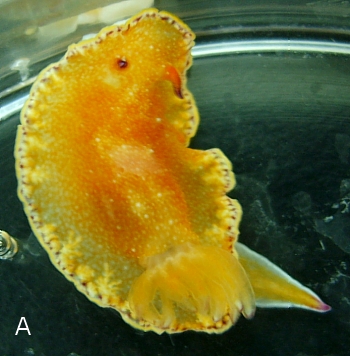
Dear Bill,
Thank you for your answer. I send you two more photos of other specimens from Yucatan, one photo is from a juvenile (3 mm), found in the same day than of the specimen I did send you before and the other photo is from a large specimen (2.5 cm) found on the same kind of sponge but in another dive. In this moment I don't have a photo of the sponge, I' ll try to get one later.
Locality: Sisal, 18 m, Yucatan, Mexico, Gulf of Mexico, August 2007. Lengths: A, 25 mm; B, 3 mm. Photographer: Jazmin Ortigosa.
Best regards,
Jazmin Ortigosa
jazmindeneb@hotmail.com
Ortigosa, J., 2007 (Oct 10) More photos of Chromodoris cf regalis. [Message in] Sea Slug Forum. Australian Museum, Sydney. Available from http://www.seaslugforum.net/find/20924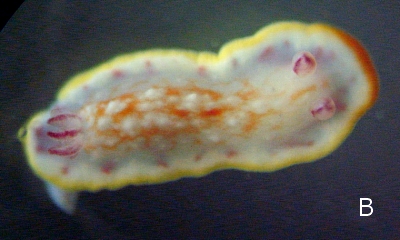
Dear Jazmin,
Thanks for the extra photos. Interestingly, I think you might have two different species here. The juvenile [Photo B] has much the same colour pattern as your earlier photo, with purple-red lines down the white rhinophores and purple-red edge to the translucent white gills. The foot seems to be white with purplish dusting at the posterior tip.
On the other hand, the large animal [Photo A] has a yellowish background colour, the rhinophores are dark orange with a red-purple tip and the gills are yellow with no sign of a red or purple edge. Also the foot is yellow with a thin white edge, with some purple at the posterior tip.
It is possible that the animal changes colour as it grows, but you will need to consider the real possibility that your have two very similarly coloured species living together. Chromodorid nudibranchs are well-known for having groups of very similar looking species. I guess what you will need to do is check some more animals and see if you can find individuals with intermediate colour patterns or to see if you can find animals laying egg ribbons. If they are different there is a possibility that they have different egg ribbons. All I can say is that neither colour form looks like C. regalis. If you are collecting specimens it is vital that you keep ones you photograph separately, so that if you later find anatomical differences you know which anatomy fits eats colour form.
In the yellow animal you can see the branched whitish mantle glands on the left side near the gills.
Best wishes,
Bill Rudman
Chromodorid from the Gulf of Mexico
October 5, 2007
From: Jazmin Ortigosa
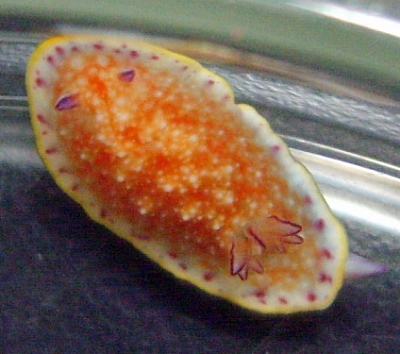
Dear Bill,
I have collected several specimens of this chromodorid in Yucatan, Mexico. All crawling over a purple sponge. About 18 m deep. All specimens sized 3-10 mm. Can anyone give me any clue on what can it be?
Locality: Sisal , 18 m, Yucatan, Mexico, Gulf of Mexico, 8 Agust 2007. Length: 10 mm. Photographer: Jazmin Ortigosa.
Best regards,
Jazmin Ortigosa
jazmindeneb@hotmail.com
Ortigosa, J., 2007 (Oct 5) Chromodorid from the Gulf of Mexico. [Message in] Sea Slug Forum. Australian Museum, Sydney. Available from http://www.seaslugforum.net/find/20827Dear Jazmin,
This looks quite like Chromodoris regalis but the purple coloration on the gills and rhinophores and the spots around the mantle edge look rather different. There also seems to be a purplish coloration on the posterior part of the foot which is also different.
I would be very interested in seeing more photos of this animal and some photos of the sponge it was on. It seems to be an unnamed species but it would be nice to get a fuller picture of its colour pattern and possible food sponge. I'll call it Chromodoris cf regalis as it is easier to remember 'lookalikes' than a number in the species list. There is always the possibility I have missed a recent publication so if anyone recognises this species I would appreciate a reply
Best wishes,
Bill Rudman
